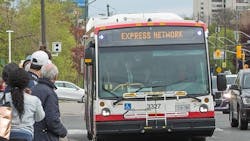TTC continues to prioritize busiest routes for service
The Toronto Transit Commission (TTC) continues to use ridership demand in the city’s inner suburbs to guide its service delivery to ensure those who are most reliant on public transit are getting the best service possible as part of the city of Toronto’s commitment to equity for all residents.
While overall system ridership is at approximately 32 percent of pre-pandemic levels, the bus network continues to see ridership in the 40-to-45 percent range.
In response, the TTC recalled all operators in November, and through a combination of schedule adjustments and buses available to deploy as needed, is putting out more service on many of the busy routes than was in place prior to the pandemic. Among the routes receiving extra service are: 36 Finch West, 35 Jane, 102 Markham, 54 Lawrence East, 29 Dufferin and 41 Keele.
"We are working with the TTC to make sure that in neighborhoods where we are seeing higher COVID-19 positivity, we are adding extra buses to achieve greater physical distancing on busy routes. The changes happening now, and the ones planned in the coming weeks, will deliver more capacity to match demand on our busiest bus routes," said Toronto Mayor John Tory. "The TTC will continue in 2021 to closely monitor ridership and adjust service where needed, but it is all hands-on deck. So much so that right now the TTC is re-training subway and streetcar operators to drive buses over the next two months, meaning even more buses on the road in the new year."
Throughout the pandemic, the TTC has implemented a demand-responsive service model, ensuring the busiest routes are getting the service they need while keeping customer loads as low as is realistically possible.
"The TTC is continuing to provide extra service and additional capacity in the neighborhoods that need it most," said TTC Chair Jaye Robinson. "We've seen that ridership in Toronto's north end, including parts of North York, Etobicoke and Scarborough, has been higher than in other parts of Toronto, and we will continue to focus on proactively monitoring and responding to demand in those areas."
The TTC continues to implement measures to reduce crowding for customers on busy bus routes. Resources are being reallocated from lower ridership routes in less busy periods, such as routes that serve primarily downtown-centered office travel patterns to busier routes with higher ridership demand, such as the 35 Jane and 54 Lawrence East.
To reduce crowding for customers, starting on Nov. 23, 2020, the TTC restored express bus service on busy corridors, such as Jane Street and Lawrence Avenue East. As well, the TTC is re-training subway and streetcar operators to drive buses over the next two months, meaning even more buses on the road in the new year.
"Since the beginning of the pandemic, we have been adapting to challenging circumstances and unusual pressures with a focus on ensuring the system is safe for customers and employees," said TTC CEO Rick Leary. "Every day, our service looks a little different because the ridership demands change. But we will continue to be flexible and provide the best possible service to those who are relying on us now more than ever."
As part of the 2021 Annual Service Plan that will be presented to the TTC Board next Tuesday, TTC staff are proposing to restore express bus service to add more capacity to reduce crowding for customers while closely monitoring ridership and adjusting service where needed.
If approved, the first phase of service restoration will begin in January, when express bus service will be restored on more corridors, such as Finch Avenue, Keele Street and Don Mills Road. Beyond January, the TTC will focus on optimizing capacity by balancing service levels across the city to ensure capacity matches demand and customer crowding is minimized.
On Nov. 23, the city of Toronto announced an updated and enhanced set of targeted COVID-19 measures to help the city's most vulnerable residents during the lockdown. These targeted COVID-19 equity measures build on protections already implemented, including sharing public health information, improving access to COVID-19 testing, and providing critical support to individuals and their families during this lockdown.

